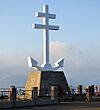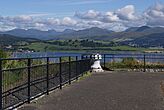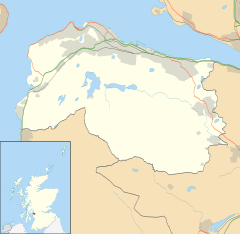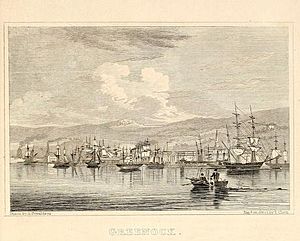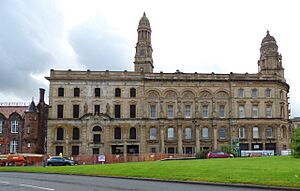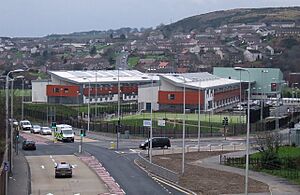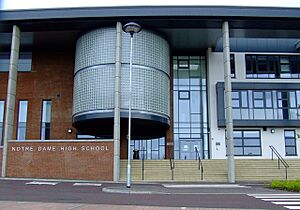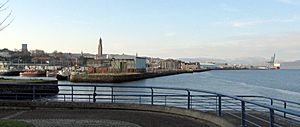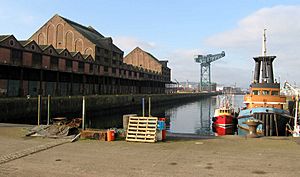Greenock facts for kids
Quick facts for kids Greenock
|
|
|---|---|
| Town and administrative centre | |
|
From top; left–right: View of Greenock from Auchmountain Road; view over Greenock and Cruise Terminal (right); Greenock Municipal Buildings; the Free France monument atop Lyle Hill; view from Lyle Hill |
|
| Area | 12.7 km2 (4.9 sq mi) |
| Population | Expression error: "Lua error in Module:Tabular_data at line 91: attempt to index field 'data' (a nil value)." must be numeric (2020) |
| Demonym | Greenockian |
| OS grid reference | NS275764 |
| • London | 360 mi (580 km) |
| Council area | |
| Lieutenancy area | |
| Country | Scotland |
| Sovereign state | United Kingdom |
| Post town | GREENOCK |
| Postcode district | PA15, PA16 |
| Dialling code | 01475 |
| Police | Strathclyde |
| Fire | Strathclyde |
| Ambulance | Scottish |
| EU Parliament | Scotland |
| UK Parliament |
|
| Scottish Parliament |
|
Greenock (![]() i/ˈɡriːnək/) is a town in Inverclyde, Scotland. It is located in the west central Lowlands of Scotland. Greenock is the main administrative center for Inverclyde Council. It used to be a special type of town called a burgh within the historic county of Renfrewshire. Greenock is connected to Gourock in the west and Port Glasgow in the east.
i/ˈɡriːnək/) is a town in Inverclyde, Scotland. It is located in the west central Lowlands of Scotland. Greenock is the main administrative center for Inverclyde Council. It used to be a special type of town called a burgh within the historic county of Renfrewshire. Greenock is connected to Gourock in the west and Port Glasgow in the east.
In 2011, Greenock had a population of 44,248 people. This was a small decrease from the 46,861 people counted in 2001. The town sits on the south bank of the River Clyde. This is where the river becomes deeper and widens into the Firth of Clyde.
Contents
History
What's in a Name?
The name Greenock has an interesting history. A scholar named William J. Watson said that its Scottish Gaelic name, Grianaig, means 'a sunny knoll'. A "knoll" is a small hill. There are other places in Scotland with similar names.
Another idea for the name comes from an older language called Common Brittonic. This suggests the name might mean 'gravelly or sandy place'. This description fits the original coastline of Greenock very well.
Over time, the town's name has been spelled in different ways. Some old records show it as Grinok, Greenhok, or Grenok. The spelling "Greenock" became common around the year 1700.
There was a story about a "green oak tree" by the Clyde. Fishermen supposedly tied their boats to it. However, there is no real proof of this tree. Most people think this story is a "folk etymology." This means it's a popular but untrue story about where a name came from. Even so, the image of a green tree has often been used as a symbol for Greenock. It appears on buildings, banners, and even the local shopping center, the Oak Mall.
Early Beginnings
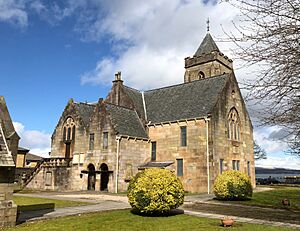
In 1296, a person named Hugh de Grenock became a Scottish Baron. A "baron" was a powerful landowner. The main home for the Greenock barony was likely what became Easter Greenock Castle.
Around 1400, the estate was split into two parts. This happened when Malcolm Galbraith, the owner, died without sons. His two daughters each inherited a part. One part became Easter Greenock, and the other became Wester Greenock.
In 1589, Sir John Schaw received permission from King James VI to build a church. This was for the local people who were mostly fishers. This church became known as the Old Kirk or the Old West Kirk. It is believed to be the first Protestant church built in Scotland after the Scottish Reformation in 1560.
The Schaw family continued to be very important in Greenock. In 1670, Sir John Shaw combined his lands to create the larger Barony of Greenock.
Busy Harbours and Shipyards
Greenock's coast had a wide bay with smaller inlets. One of these, the Bay of Quick, was known as a safe place for ships as early as 1164.
The fishing village of Greenock grew along a sandy bay. Around 1635, Sir John Schaw built a jetty into this bay. A "jetty" is a pier or landing place. This area became known as Sir John's Bay. Greenock was then made a Burgh of Barony, which gave it rights to hold a weekly market.
Fishing became very successful. Salted herring was exported widely. Shipping trade also grew. Large ships could not travel further up the River Clyde to Glasgow. So, merchants from Glasgow wanted to use Greenock's harbour.
In 1710, a new harbour was finished in Greenock. In 1711, the shipbuilding industry began. Scotts, a famous shipbuilding company, started building fishing boats. Greenock quickly became a major port and shipbuilding center. Even when ships could go directly to Glasgow later, merchants still used Greenock harbour.
The American Revolutionary War (1775-1783) briefly stopped trade. After the war, Greenock traded with more places. It imported rum and sugar from the Caribbean, wines from Spain, and fish from North America.
Custom House and Steamboats
In 1714, Greenock became a "custom house" port. A "custom house" is where taxes on imported and exported goods are collected. At first, it operated from rented rooms. As trade grew, a new Custom House building was finished in 1818. It was designed by William Burn and had a grand style with Greek-style columns. This building looked out over the quay, which was later named Custom House Quay.
In 1812, Europe's first steamboat service started. The PS Comet sailed between Glasgow, Greenock, and Helensburgh. This made travel much faster. The pier where steamboats docked became known as Steamboat Quay.
The Custom House building was used until 2010. It even had a museum about customs and taxes. After it closed, it was renovated. In 2013, companies like PG Paper Company Ltd and Toshiba moved into the building.
Industry and Railways
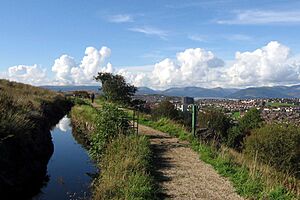
Greenock became an important industrial center. Water power was used to process goods. In 1827, Loch Thom was built as a reservoir. The Cut, an aqueduct, brought water from the loch to power mills. These mills were used for paper, cotton, wool, sugar, and shipbuilding.
Greenock Central railway station opened in 1841. This provided a fast way to travel from Glasgow to the coast. It connected with steamboat services. Later, more railway lines and stations were built, including Princes Pier. Tunnels were dug under the town for these new lines.
Greenock's growing importance was shown by the Greenock Municipal Buildings. Its Victoria Tower, finished in 1886, stands 245 feet (75 meters) tall.
A torpedo factory, the Clyde Torpedo Factory, opened in 1910. It designed and tested torpedoes. During the Second World War, it made torpedoes. After the war, it focused on research and development until it closed in 1959.
The Old West Kirk church, first built in 1591, was moved in 1926. This was to make space for the expansion of the Harland & Wolff shipyard. The church was rebuilt at a new location on the Esplanade, where it still stands. It is famous for its beautiful stained glass windows, made by artists like Dante Gabriel Rossetti and Sir Edward Burne-Jones.
Second World War
Greenock played a big role during the Second World War. Its anchorage at the Tail of the Bank was a base for the British Home Fleet. It was also the main meeting point for ships traveling in convoys across the Atlantic Ocean.
On May 6 and 7, 1941, about 300 German aircraft attacked Greenock. This event is known as the Greenock Blitz. Many buildings were damaged. The Municipal Buildings were severely hit, losing a tower and two decorative parts.
The Cross of Lorraine monument on Lyle Hill remembers the Free French Naval Forces who sailed from Greenock during the war.
After the War
Greenock did well in the years after the war. However, in the 1970s and 1980s, heavy industries declined. This led to high unemployment. In recent years, new investments and redevelopment have helped the local economy improve.
Tourism has also become important. The Clydeport container port developed into the Ocean Terminal. This is now a passenger terminal for cruise ships. Many students attend the Greenock campus of West College.
Greenock's population was largest in 1921, with 81,123 people. It was once the sixth largest town in Scotland.
Governance
Until 1974, Greenock was its own "parliamentary burgh." This meant it had its own representative in Parliament. Later, it was combined with Port Glasgow to form a larger area for political representation.
Today, Greenock is the administrative center of Inverclyde Council. This is the local government responsible for the wider Inverclyde area. The council is based in the Greenock Municipal Buildings.
Climate
| Weather chart for Greenock | |||||||||||||||||||||||||||||||||||||||||||||||
|---|---|---|---|---|---|---|---|---|---|---|---|---|---|---|---|---|---|---|---|---|---|---|---|---|---|---|---|---|---|---|---|---|---|---|---|---|---|---|---|---|---|---|---|---|---|---|---|
| J | F | M | A | M | J | J | A | S | O | N | D | ||||||||||||||||||||||||||||||||||||
|
75
6
1
|
55
7
1
|
54
8
2
|
38
11
3
|
34
15
6
|
35
17
9
|
39
19
11
|
52
18
11
|
45
16
8
|
81
12
6
|
68
9
3
|
69
7
2
|
||||||||||||||||||||||||||||||||||||
| temperatures in °C precipitation totals in mm source: Precipitation: |
|||||||||||||||||||||||||||||||||||||||||||||||
|
Imperial conversion
|
|||||||||||||||||||||||||||||||||||||||||||||||
Greenock has a temperate maritime climate. This means it has cool summers and mild winters. Because it's on the coast, the ocean helps keep winter temperatures warmer than places further inland.
Greenock is known for having a lot of rain. While it does get more rain than the average for Scottish weather stations, the wettest places in Scotland are actually in the mountains.
Greenock's location means it has long hours of daylight in summer. The sun rises early and sets late in June. In winter, the opposite is true, with shorter days.
Education
Greenock has several primary schools and high schools. The Highlanders Academy was built in 1837.
As of 2023, Greenock's primary schools include:
- Ardgowan Primary School
- Lady Alice Primary School
- St Josephs R C Primary School
- St Mary's Catholic Primary School
- St Patricks Primary School
- Whinhill Primary School
- Aileymill Primary School
- St Andrew's Primary School
- All Saints Primary School
- King's Oak Primary School
The high schools in Greenock as of 2023 are:
- Notre Dame High School
- Inverclyde Academy
- Clydeview Academy
Greenock also has Lomond View Academy. A private school, the Cedars School of Excellence, closed in September 2024 after 25 years.
Health
Greenock has important health facilities. The Greenock Royal Infirmary was first set up in 1809. Today, the town is served by the Inverclyde Royal Hospital. This hospital provides care for people in Inverclyde and nearby areas. It was built to replace several older hospitals and was completed in 1979.
In 2004, there were plans to reduce some services at Inverclyde Royal Hospital. However, after a review, it was decided to keep important services like the accident and emergency department.
Langhill Clinic, located near Inverclyde Royal Hospital, is a hospital that provides mental health care.
Economy
Greenock's Economic Journey
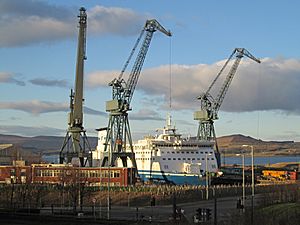
In the past, Greenock's economy depended on shipbuilding, sugar refining, and wool manufacturing. These industries are no longer a main part of Greenock's economy. More recently, electronics manufacturing was important. Now, the town mostly relies on:
- Call centers
- Insurance
- Banking
- Shipping exports
The Fleming and Reid wool mill used to employ 500 people, mostly women. They made wool clothes.
In October 2012, Greenock had an unemployment rate of 5.3%. This was higher than the Scottish average of 3.9%.
Shipbuilding History
Shipbuilding has been important in Greenock for a long time. The first pier was built in the early 1600s. The first proper harbour was finished in 1710. Scotts Shipbuilding and Engineering Company, a well-known shipbuilder, started in 1711. They built many ships for the Royal Navy.
In 1967, Scotts merged with Lithgows to become Scott Lithgow. This company was later taken over by the government in 1977. From 1800 to 1980, thousands of people worked in shipbuilding in Greenock. However, due to competition from other countries, most of these companies closed in the 1970s and 1980s.
Today, shipbuilding continues at Ferguson Marine Engineering in nearby Port Glasgow. Ship repair work still happens at the Garvel Drydock in Greenock's Great Harbour.
The Inchgreen Drydock opened in 1964. It was one of the largest in the world. It was used to repair big ships like the RMS Queen Elizabeth and to finish building the QE2. In November 2021, it was announced that the dock would be used for breaking up old marine vessels.
Shipping Today

Greenock's Ocean Terminal handles freight traffic with large cranes. This terminal is also a regular stop for cruise liners visiting the west of Scotland.
In the 1950s and 1960s, Greenock was a common stop for major shipping lines like Cunard Line. Large ships would anchor in the Firth of Clyde, and smaller ferries would take passengers to shore.
Greenock's Great Harbour also helps support the Royal Navy. "Admiralty" boats and tugs are often seen on the Clyde.
Greenock has a lovely esplanade, which is a riverside walk. It stretches for over a mile from the Ocean Terminal to the Royal West of Scotland Amateur Boat Club. This club offers sailing, kayaking, and rowing.
The Sweet History of Sugar
Sugar refining started in Greenock in 1765. Many sugar refineries operated in the town. One of the most successful was Tate & Lyle. This company was formed in 1921 by a merger of two sugar businesses.
The James Watt Dock, opened in 1886, had a large warehouse called the Sugar Shed. This was used for both raw sugar coming in and refined sugar ready to be sent out. By the late 1800s, about 400 ships each year brought sugar from the Caribbean to Greenock for processing.
When Tate and Lyle closed its Greenock refinery in 1997, it ended the town's 150-year connection with sugar making. A new sugar warehouse continued shipping operations at Greenock's Ocean Terminal. The old Sugar Shed at James Watt Dock is now a protected building. A fire in 2006 caused damage, but the building and the area around it now include a marina.
Electronics and Modern Jobs
Since IBM arrived in Greenock in 1951, electronics and light manufacturing were important for jobs. Texas Instruments also had a silicon wafer plant in the town from 1970 until 2019.
However, many manufacturing jobs have moved to other countries. Now, jobs have shifted to the "service sector," especially call centers. EE and IBM have large call center operations in Greenock. The Royal Bank of Scotland Mortgage Centre also processes mortgage applications there.
The former IBM factory in Greenock has been demolished. Another electronics company, Sanmina, took over some of the IBM buildings but later moved jobs to Hungary. The Sanmina plant has also closed and was demolished. The area is now called "Valley Park."
Shopping and Commerce
Greenock's main shopping area used to be Hamilton Street. In 1975, this area was made into a pedestrian zone called Hamilton Way. In 1992, it was covered and became The Oak Mall.
The Oak Mall has faced challenges. It has had issues with flooding from leaks. As part of new development plans for Greenock, the eastern side of the Oak Mall, along with a nearby road and building, will be taken down starting in 2025.
Many well-known stores have been in the Oak Mall. A Marks and Spencer store opened in 1936. It later moved to Port Glasgow. Woolworths also had a store there, which was replaced by a Wilkinsons store, and then by a Poundland.
Tesco opened its first Scottish store in Greenock in 1970. Today, Tesco has a store on Dalrymple Street. Other major supermarkets like Aldi, Lidl, and Morrisons also have stores in Greenock.
Transport
Greenock has many railway stations, more than most towns in Scotland. It has eight stations: Bogston, Cartsdyke, Greenock Central, Greenock West, Fort Matilda, Whinhill, Drumfrochar, and Branchton. There is also a ninth station at the former IBM complex, which is currently not in use. Greenock has a railway tunnel that is 1.2 miles (1.9 km) long.
A new £20 million ocean terminal opened in August 2023. This terminal is expected to welcome over 100 cruise ships each year. It has already hosted major ships, including the new Cunard ship MS Queen Anne on its first journey. In March 2024, Princess Anne visited the terminal as part of a royal event.
Greenock is served by many local bus routes. These buses cover Greenock, Gourock, and Port Glasgow. Long-distance buses travel to Glasgow, Largs, and Dunoon. Most routes are run by McGill's Bus Services.
Greenock is at the end of the A8 road and M8 motorway, which starts in Edinburgh. It is also the northern end of Euroroute E05, which goes south through England, France, and Spain.
Culture
Greenock is home to the world's first Burns Club. This club was founded in 1801 by merchants from Ayrshire, some of whom knew the famous poet Robert Burns. They held the world's first Burns Supper in 1802.
The Watt Institution (McLean Museum) is the largest museum in the Inverclyde area. It has exhibits about James Watt, fine arts, shipbuilding history, and even ancient Egyptian artifacts.
The Beacon Arts Centre opened in 2013. It is a new building on Greenock's Custom House Quay. It has a 500-seat theater for plays, concerts, and other events. It also has a Studio Theatre and a Gallery Suite with views over the Clyde. There is a café and bar on the ground floor.
Next to the Custom House Quay is The Wyllieum. This museum opened in April 2024 and celebrates George Wyllie, a Scottish artist who lived in Inverclyde.
Greenock hosted the Royal National Mòd, a Scottish Gaelic festival, in 1904 and 1925.
Greenock on Screen
Greenock has been a setting for several TV shows and films.
- The 1974 BBC Scotland show The Vital Spark was filmed in Greenock.
- In 2012, the BBC drama Waterloo Road moved its filming to Greenock. It was shot at Greenock Academy, a former school.
- The British TV series Annika uses the Beacon Arts Centre as a base for its police unit.
Films set in Greenock include Sweet Sixteen (2002) and Dear Frankie (2004). In the film Rob Roy, Greenock is called "the port to new world."
Greenock in Books
Greenock appears in several books:
- Alan Sharp's 1965 novel A Green Tree in Gedde.
- Robin Jenkins' 1979 novel Fergus Lamont calls Greenock 'Gantock'.
- Alasdair Gray's 1984 novel 1982, Janine is set in a Greenock hotel room.
- Matthew Fitt's novel But'n'Ben A-Go-Go shows a Greenock that is underwater due to global warming.
- The novel The Greenock Murders by Kieran James (2021) is set in Greenock.
The French writer Charles Nodier described Greenock as "one of the ornaments of Renfrewshire" in his 1821 travel book.
Local Media
Greenock has a daily evening newspaper called The Greenock Telegraph, which started in 1857.
Local news and TV programs are provided by BBC Scotland and STV Central. Inverclyde TV is an online TV station run by students at West College Scotland. Inverclyde FM is a community online radio station run by volunteers.
Famous People from Greenock

The most famous person from Greenock is the engineer James Watt. He is remembered in many places in the town, including a library and a college building on the site of his birthplace.
Other notable people from Greenock include:
- John McGeoch, a very influential rock guitarist.
- Actors Richard Wilson, Martin Compston, and Stella Gonet.
- Comedian Charles 'Chic' Murray.
- Antarctic explorer Henry Robertson 'Birdie' Bowers.
- Julianne Moore, a famous American actress, is the daughter of Anne Love, who was born in Greenock.
- Rosé, a contestant on RuPaul's Drag Race, was born in Greenock.
- Angela Egan, the 2021 winner of Dancing on Ice, was born in Greenock.
Robert Burns' love, Mary Campbell (Highland Mary), died in Greenock in 1786. She is buried in Greenock Cemetery. The novelist John Galt, who founded Guelph, Ontario, lived in Greenock and is buried there.
Sports
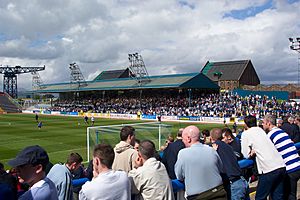
Greenock Morton is the local professional football team. They play in the Scottish Championship. The team was founded in 1874 as Morton F.C. They play their home games at Cappielow.
Greenock also has a rugby union team, Greenock Wanderers RFC, which was founded in 1873. It is one of the oldest rugby clubs in Scotland.
There are two successful athletics clubs in Greenock: Inverclyde AC and Glenpark Harriers. The town also has the Greenock Cricket Club and Greenock Golf Club.
In 1972, Greenock hosted the first official international women's football match played in Britain. Scotland played England, and England won 3-2.
Inverclyde Leisure provides many sports facilities in Greenock and the surrounding area:
- Waterfront Leisure Complex
- Greenock Sports Centre
- Lady Octavia Sports Centre
- Boglestone Community Centre and Fitness Gym
- Ravenscraig Sports Centre
- Battery Park Pavilion
- Gourock Fitness Gym
- Gourock Outdoor Swimming Pool
- Birkmyre Park Fitness Gym (Kilmacolm)
Plans for a new multi-purpose sports facility at Rankin Park were proposed in 2009 and again in 2021. However, due to rising costs, it is uncertain if these plans will go ahead.
See also
 In Spanish: Greenock para niños
In Spanish: Greenock para niños





